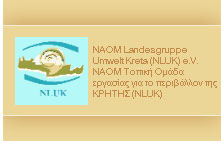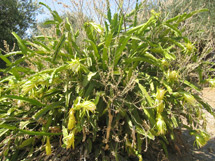
![]() Informationen
Informationen
![]() Informations
Informations
![]() Πληροφορίες του NLUK
Πληροφορίες του NLUK
Copyright © 2022 Kreta-Umweltforum
Botanical
In ancient times Crete was densely wooded and rank.
Today, because of destruction by climate and soil but
also by forces of nature and conqueror which suffered
the island over the centuries, the growth of climate
and soil, has declined.
The diversity of species of plants should be still considerable;
reportedly estimates approximately 2,000 plants still grow in Crete,
160 types of them (mainly herbs) are endemic (occur only in Crete).
Rare plants are primarily found in canyons and isolated mountain slopes,
once in a while also along the coast and on the plateaus.

The illustration shows a “Queen of the night” (Holocereus undatus) in the morning after night flower. The approx. 2 m high Cactus can be found in savaged form (very rarely).
Leaflets
Orchids of Crete:
An 18-piece leaflet series describes 61 of 65 Orchids species occurring on Crete; the particular leaflets (Part 1 - 18) can be found here:
Orchids of Crete - Part 1 - 18
082-05/E - Crete's climate and vegetation 085-05/E - Crete’s vegetation on the peninsula of Akrotiri
093-05/E - Cretan orchid
(Ophrys cretica ssp. –ariadne)
111-05/E - Carnations 112-05/E - Potatos
155-06(E - Cretan Date Palm
(Phoenix theophrastii)
276-08/E - Storax
(Styrax officinalis)
289-09/E - Cretan birthwort
(Aristolochia cretica)
330-10/E - The Blue Jacaranda
(Jacaranda mimosifolia)
334-10/E - Bird of paradise
(Caesalpinia gilliesii)
336-10/E - A potrait of bananas
(Musa L.)
345-10/E - Okra
(Abelmoschus esculentus)
350-11/E - Sourgrass
(Oxalis pes-caprae)
372-12/E - The Cretan bellflower (Petromarula pinnata)
372-12/E - The Bladder cherry
(Physalis alkekengi)
376-12/E - Evergreen Birthwort
Aristolochia sempervirens)
384-12/E - The Great Horsetail
(Equisetum telmateia)
392-12/E - Carpobrotus acinaciformis
393-12/E - Deadly carrots
(Thapsia garganica)
394-12/E - The “Cola tree”
(Cola acuminata)
395-12/E - Narrowleaf bugloss
(Echium angustifolium)
398-12/E - The western arbutus
(Arbutus unedo)
399-12/E - Sand or Sea daffodil
(Pancratium maritimum)
618-17/E - Bladder kidney-vetch
(Tripodion tetraphyllum)
Please see 2nd Page of the leaflet
for the individual topic
008-04/E - Agave
(Agave americana)
009-04/E - Ebony wood bush
(Cretica ebebus)
012-04/E - Leek
(Allium communatum)
023-04/E - Prickly Pear
(Opuntia ssp.)
024-04/E - St. John's bread
(Ceratonia siliqua)
026-04/E - Cretan Dittany / Erodas
(Oreganum dictamnus)
030-04/E - Mediterranean Cypress
(Cupressus sempervirens)
041-04/E - Sea squill / sea onion
(Urginea maritima)
044-04/E - Pomegranate
(Punica granatum)
047-04/E - Chestnuts
(Kastanea sativa)
056-04/E - Fig tree (Ficus carica)
Kermes Oak (Quercus coccifera)
063-05/E - Blackberry
(Rubus fructicosus)
068-05/E - Friar’s Cowl
(Arisarum vulgare)
073-05/E - Orange (Citrus sinensis) / Lemon (Citrus limon)
076-05/E - Firethorn (Pyracantha) /
Willow-leafed pear (Pyrus)
100-05/E - Almond
(Prunus dulcis)
109-05/E - Giant fennel
(Ferula communis)
122-05/E - Bougainvillea
(Bougainvillea spectabilis)
126-05/E - "Belle of the night"[Dragonfruit]
(Hylocereus undatus)
191-06/E - Artichoke
(Cynara scolymus)
376-12/E - Cretan Amaranth
(Amaranthus graecizans)